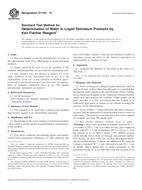Potrebujeme váš súhlas na využitie jednotlivých dát, aby sa vám okrem iného mohli ukazovať informácie týkajúce sa vašich záujmov. Súhlas udelíte kliknutím na tlačidlo „OK“.
ASTM D7415-09
Standard Test Method for Condition Monitoring of Sulfate By-Products in In-Service Petroleum and Hydrocarbon Based Lubricants by Trend Analysis Using Fourier Transform Infrared (FT-IR) Spectrometry
Automaticky preložený názov:
Štandardná skúšobná metóda pre sledovanie stavu síranu vedľajších produktov v prevádzke ropu a na báze uhľovodíka mazív Trend analýzy pomocou Fourier Transform Infrared (FT-IR) spektrometria
NORMA vydaná dňa 1.7.2009
Informácie o norme:
Označenie normy: ASTM D7415-09
Poznámka: NEPLATNÁ
Dátum vydania normy: 1.7.2009
Kód tovaru: NS-38394
Počet strán: 5
Približná hmotnosť: 15 g (0.03 libier)
Krajina: Americká technická norma
Kategória: Technické normy ASTM
Kategórie - podobné normy:
Anotácia textu normy ASTM D7415-09 :
Keywords:
condition monitoring, differential trend analysis, direct trend analysis, Fourier transform infrared, FT-IR, hydrocarbon based lubricants, in-service petroleum lubricants, infrared, IR, lubricants, oils, sulfate by-products, ICS Number Code 75.100 (Lubricants, industrial oils and related products)
Doplňujúce informácie
| Significance and Use | ||||||||||||||||||||||
|
An increase in sulfate material can be an indicator of oil degradation caused by oxidation of sulfur in the oil and sulfur in fuel. It can also indicate the breakdown or oxidation of some key additives in the oil such as antiwear and extreme pressure additives as well as blow-by concerns. As oxidized sulfur from blow-by enters the lubricant, it will consume the overbase additive to generate sulfate by-products. Monitoring of sulfate by-products is therefore an important parameter in determining overall machinery health and in determining additive depletion and should be considered in conjunction with data from other tests such as atomic emission (AE) and atomic absorption (AA) spectroscopy for wear metal analysis (Test Method D 5185), physical property tests (Test Methods D 445, D 2896, and D 6304), base number tests (Test Methods D 974 and D 4739) and other FT-IR oil analysis methods for nitration (Practice E 2412), oxidation (Test Method D 7414), additive depletion (Test Method D 7412), breakdown products and external contaminants (Practice E 2412), which also assess elements of the oil’s condition, see Refs (1-6) |
||||||||||||||||||||||
| 1. Scope | ||||||||||||||||||||||
|
1.1 This test method covers monitoring sulfate by-products in in-service petroleum and hydrocarbon based diesel crankcase engine and motor oils that have a sulfur content of greater than 500 ppm. This test method should not be employed when low-sulfur fuels are used for combustion. 1.2 This test method uses Fourier Transform Infrared (FT-IR) spectrometry for monitoring build-up of sulfate by-products in in-service petroleum and hydrocarbon based lubricants as a result of normal machinery operation. Sulfate by-products can result from the introduction of sulfur from combustion or from the oxidation of sulfur-containing base oil additives. This test method is designed as a fast, simple spectroscopic check for monitoring of sulfate by-products in in-service petroleum and hydrocarbon based lubricants with the objective of helping diagnose the operational condition of the machine based on measuring the level of sulfate by-products in the oil. 1.3 Acquisition of FT-IR spectral data for measuring sulfate by-products in in-service oil and lubricant samples is described in Practice D 7418. In this test method, measurement and data interpretation parameters for sulfate by-products using both direct trend analysis and differential (spectral subtraction) trend analysis are presented. 1.4 This test method is based on trending of spectral changes associated with sulfate by-products of in-service petroleum and hydrocarbon based lubricants. Warnings or alarm limits can be set on the basis of a fixed minimum value for a single measurement or, alternatively, can be based on a rate of change of the response measured, see Ref (1). 1.4.1 For direct trend analysis, values are recorded directly from absorption spectra and reported in units of absorbance per 0.1 mm pathlength. 1.4.2 For differential trend analysis, values are recorded from the differential spectra (spectrum obtained by subtraction of the absorption spectrum of the reference oil from that of the in-service oil) and reported in units of 100*absorbance per 0.1 mm pathlength (or equivalently absorbance units per centimetre). 1.4.3 In either case, maintenance action limits should be determined through statistical analysis, history of the same or similar equipment, round robin tests or other methods in conjunction with the correlation of sulfate by-product changes to equipment performance. Note 1—It is not the intent of this test method to establish or recommend normal, cautionary, warning or alert limits for any machinery. Such limits should be established in conjunction with advice and guidance from the machinery manufacturer and maintenance group. 1.5 This test method is for petroleum and hydrocarbon based lubricants and is not applicable for ester based oils, including polyol esters or phosphate esters. 1.6 The values stated in SI units are to be regarded as standard. No other units of measurement are included in this standard. 1.6.1 Exception—The unit for wave numbers is cm-1. 1.7 This standard does not purport to address all of the safety concerns, if any, associated with its use. It is the responsibility of the user of this standard to establish appropriate safety and health practices and determine the applicability of regulatory limitations prior to use. |
||||||||||||||||||||||
| 2. Referenced Documents | ||||||||||||||||||||||
|
Podobné normy:
Historická
1.1.2014
Historická
1.12.2013
Historická
1.5.2013
Historická
1.12.2013
Historická
1.1.2011
Historická
1.5.2010
Odporúčame:
Aktualizácia technických noriem
Chcete mať istotu, že používate len platné technické normy?
Ponúkame Vám riešenie, ktoré Vám zaistí mesačný prehľad o aktuálnosti noriem, ktoré používate.
Chcete vedieť viac informácií ? Pozrite sa na túto stránku.



 ASTM D1662-08(2014)..
ASTM D1662-08(2014).. ASTM D1742-06(2013)..
ASTM D1742-06(2013).. ASTM D1743-13
ASTM D1743-13 ASTM D1744-13
ASTM D1744-13 ASTM D1831-11
ASTM D1831-11 ASTM D217-10
ASTM D217-10
 Cookies
Cookies
